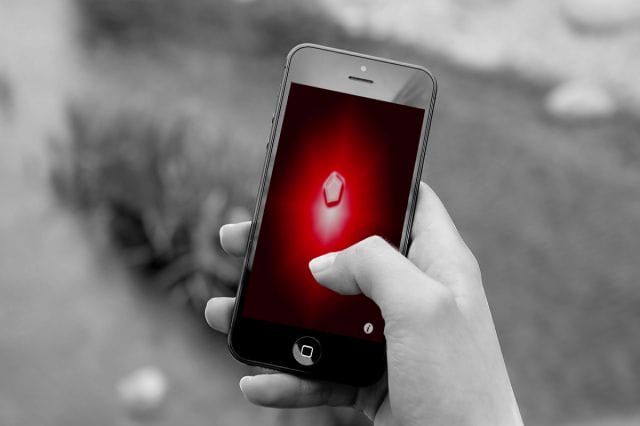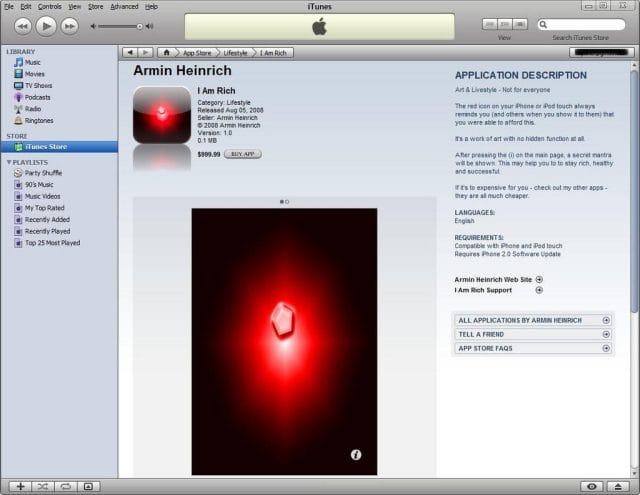
![]()
In early 2008, developer Armin Heinrich sat down at his desk to design an app for the newly released first generation iPhone. It had to be a moneymaker, he figured; more importantly, it had to demonstrate his sense of humor. Ultimately, he settled on an idea that kept his input costs extremely low and his potential profits high: he’d develop an app that did absolutely nothing, for which the buyer would pay a disproportionately high price — the highest in the entire app store.
His app, “I Am Rich,” did just that: for $999.99 (the steepest price for an app that Apple allows), a purchaser would gain access to the app, which was nothing more than a glowing, red orb. But having the ruby on your screen meant that you were rich — clearly, you had to be, to afford to pay $1,000 for something so utterly useless. Heinrich’s intention was to create the ultimate Veblen good in app form: something desirable merely due to its price and exclusivity. With an enticing description, “I Am Rich” was listed in Apple’s App Store on August 5, 2008:
“The red icon on your iPhone or iPod touch always reminds you (and others when you show it to them) that you were able to afford this.
It’s a work of art with no hidden function at all.
After pressing the (i) on the main page, a secret mantra will be shown. This may help you to stay rich, healthy and successful.”
Shockingly, in a span of just a few hours, 8 people purchased the app — 5 in the United States, one in Germany, and one in France. But Heinrich’s original plan had failed: it wasn’t being bought by rich folks looking to show it off, but rather by curious people who thought it was a joke. One reviewer (Lee5279xx) was so riled up that he was actually charged for the application that he wrote a ranting review:
“This is not a joke! I need someone from apple to help me with this scam. I saw this app with a few friends and we jokingly clicked ‘buy’ thinking it was a JOKE, to see what would happen….I called my visa card and they verified I was charged $999.99. THIS IS NO JOKE. DO NOT BUY THIS APP. BEWARE…”
Less than a full day after hitting the app store, Apple removed I Am Rich with no explanation, but not before Heinrich had made away with $5,600 (after Apple had taken its 30% “store upkeep fee” of $2,400).
“I have no idea why they [took it down],” he told the Los Angeles Times in an interview a few days later, “and I’m not aware of any violation of the rules to sell software on the App Store.” Heinrich hadn’t, in fact, broken any of Apple’s guidelines, but the company, to this day, has never addressed its propensity for selectively taking down apps it deems unfit.
Apple, which maintains a lengthy set of guidelines for IOS developers, most likely determined that “I Am Rich” wasn’t “functional” (2.12), or classified it as “objectionable content” (16.1).

In the aftermath of the “I Am Rich” debacle, two of the eight buyers extensively complained to Apple and were issued full refunds. “I don’t want to collect money from people who did this by accident,” he later said. “I am glad that Apple returned the money for two orders.”
But Heinrich also admitted that he was a bit disappointed about his creation’s short lifespan, as he felt there was demand for it. “I am sure a lot more people would like to buy it, but currently can’t do so. The App is a work of Art and included a ‘secret mantra,’ that’s all.” Multiple customers, he adds, emailed him saying they loved the app and had “no trouble spending the money” (though this was never verified).
And what exactly was the “secret mantra“ that his customers had supposedly “raved” about having access to? Let’s just say that it must have taken a special buyer to see a thousand dollars of value in it (notice the artistic lack of punctuation and the fashionable misspelling of “deserve”):
I AM RICH
I DESERV IT
I AM GOOD, HEALTHY &
SUCCESSFUL
The following year, due to popular demand, Heinrich, released “I Am Rich LE,” a more affordable version priced at $9.99; it’s still available for purchase today. This time around, the app even houses a few features (due to Apple’s policy that an app must contain some sort of “definable content”): a calculator for “basic financial calculations,” an “in-built help system,” and the “famous mantra without the spelling mistakes.”
To date, the app has 67 reviews, and holds an average 2.5 out of 5 stars rating, though most of the one-star ratings are due to the fact that the app actually contains something useful. “Can you please make this app so it does absolutely nothing like the first one?” implores one customer. “I didn’t buy this app to get my money’s worth.”
“It’s art and it’s brilliant,” writes another, more satisfied buyer. “Not everything you pay for has to have value. Screw practicality.”
![]()
This post was written by Zachary Crockett. You can follow him on Twitter here.
To get occasional notifications when we write blog posts, please sign up for our email list.



